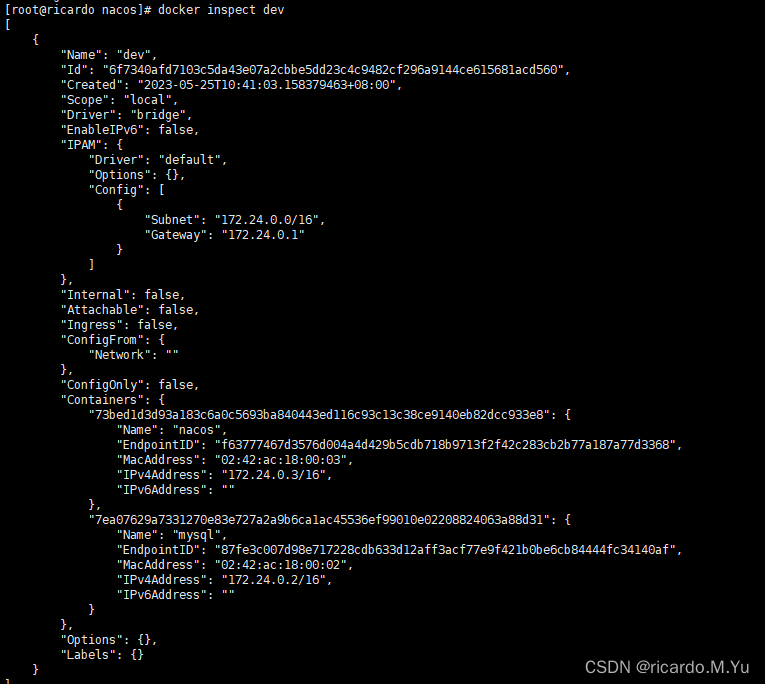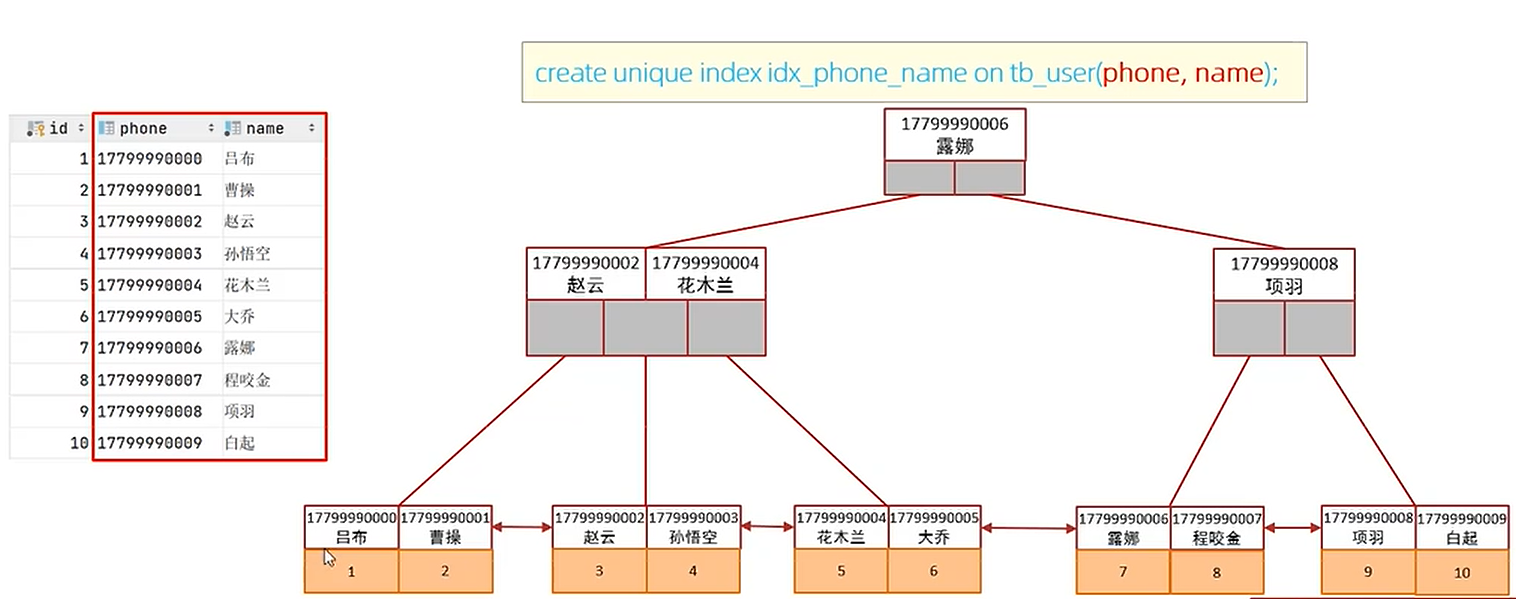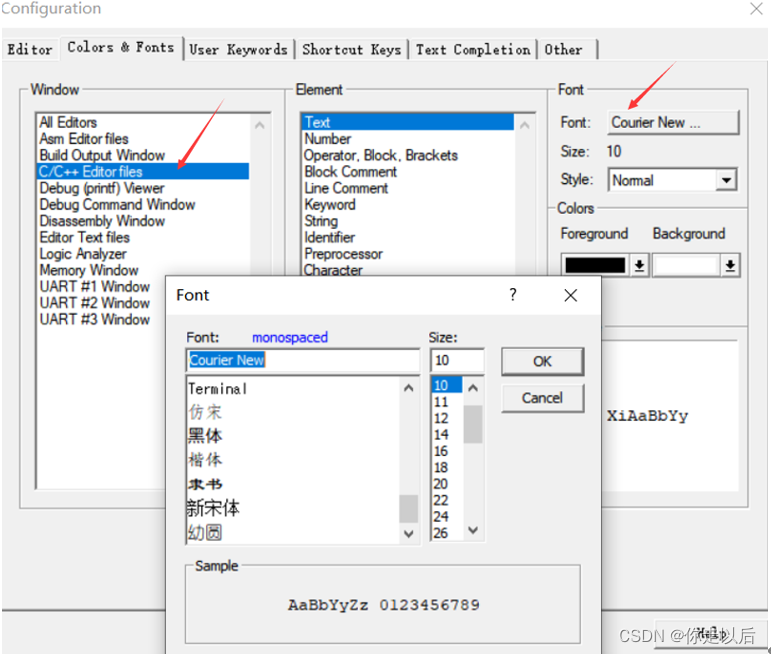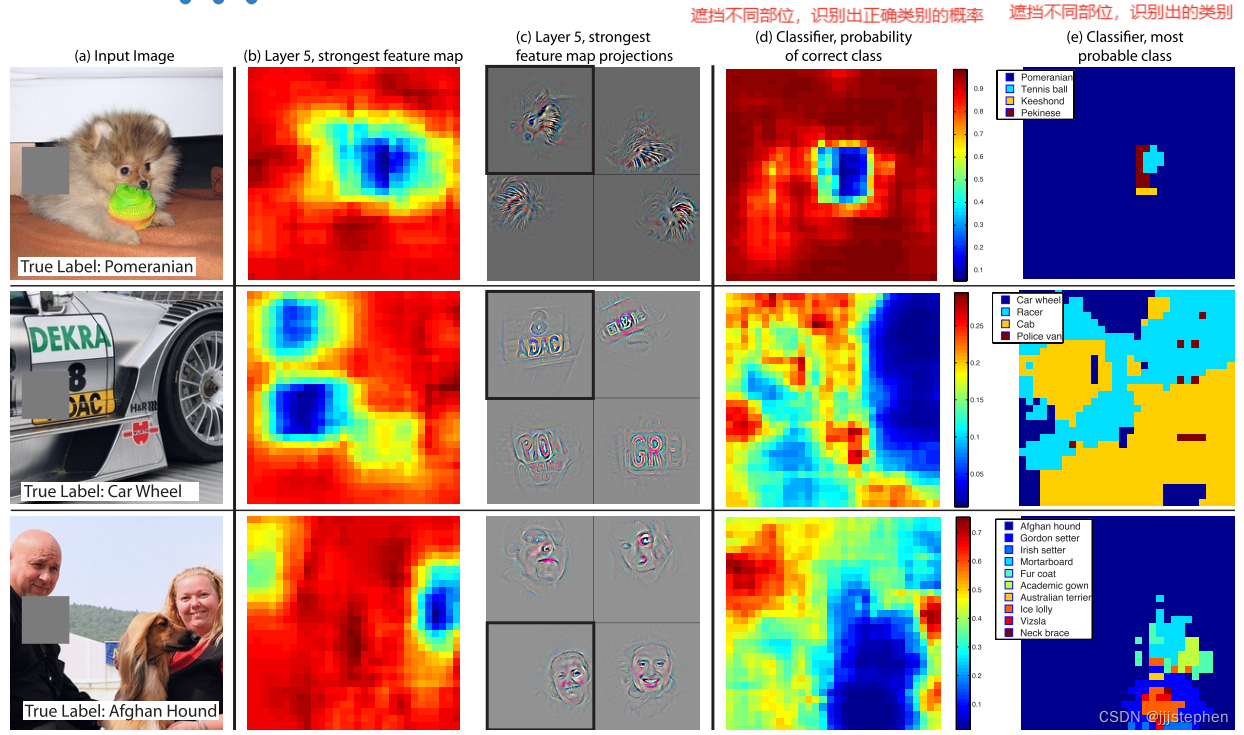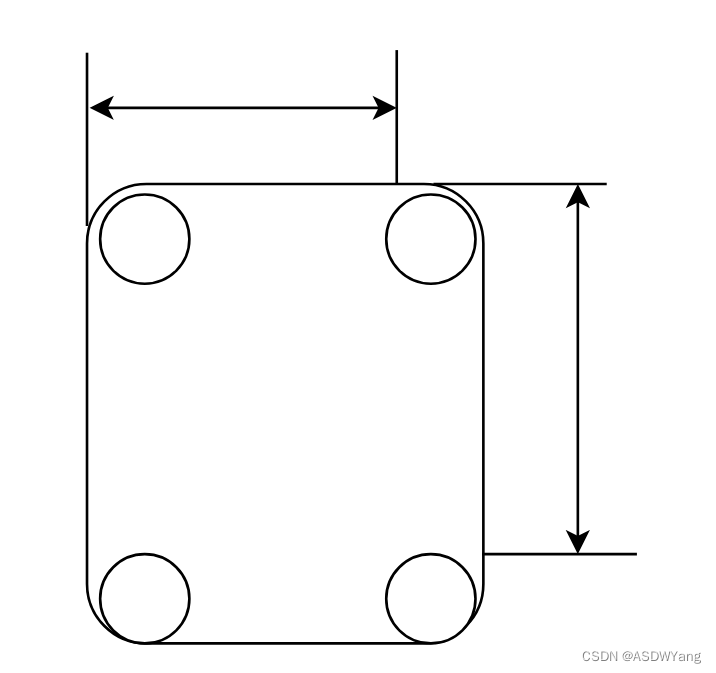mjpg-streamer框架分析
文章目录
- mjpg-streamer框架分析
- 框架
- main
- input_init
- input_run
- output_init
框架
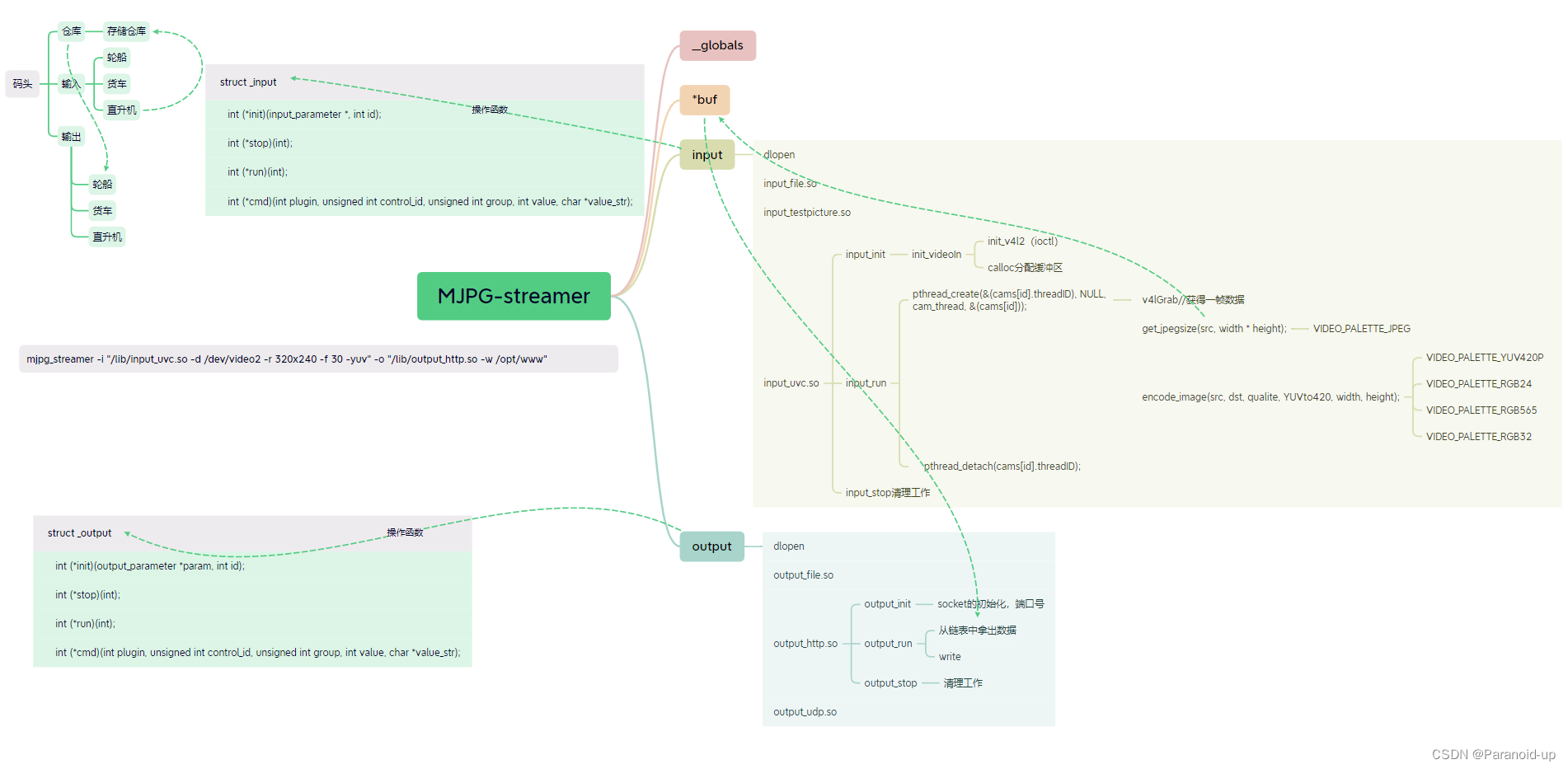
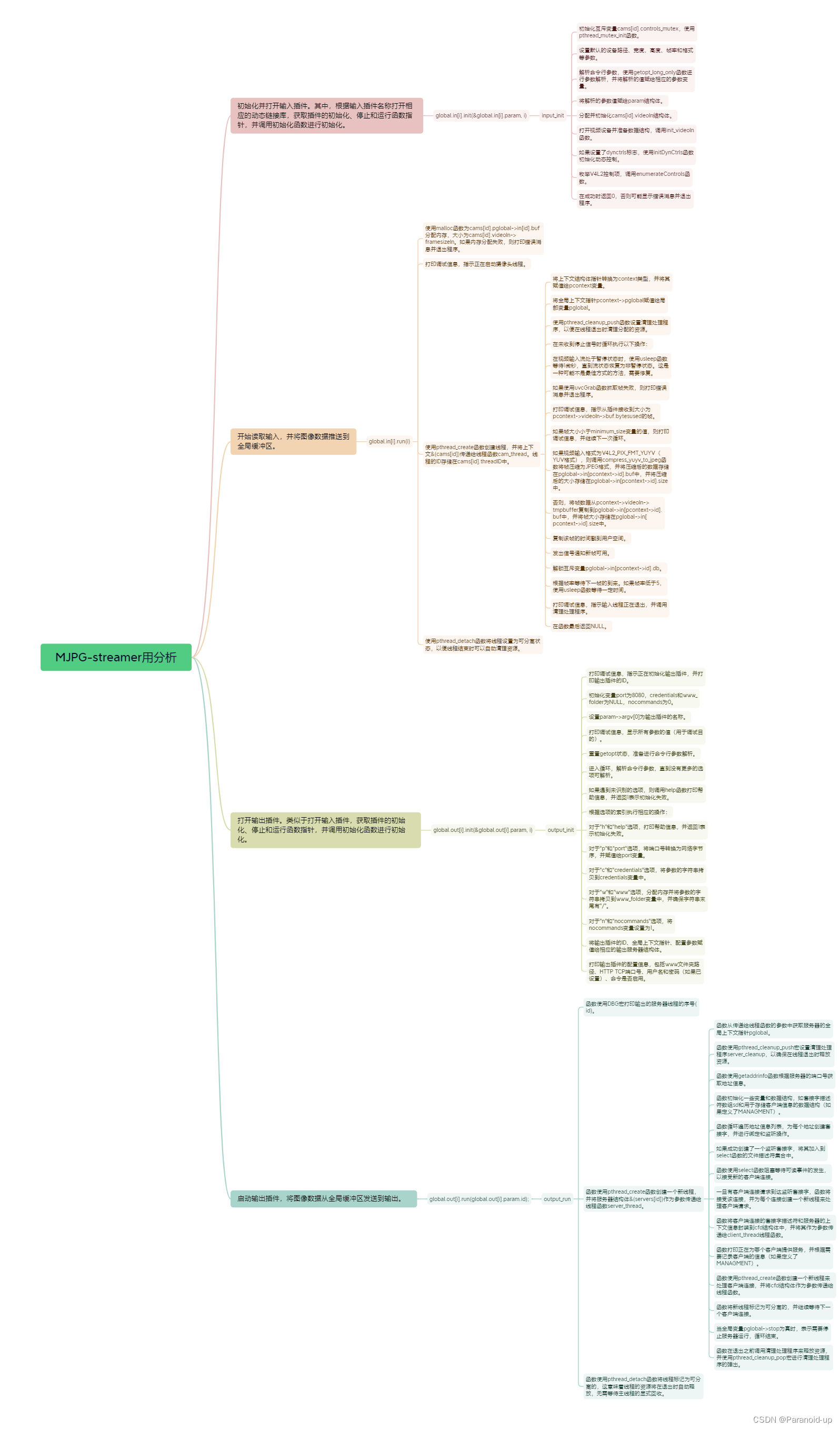
main
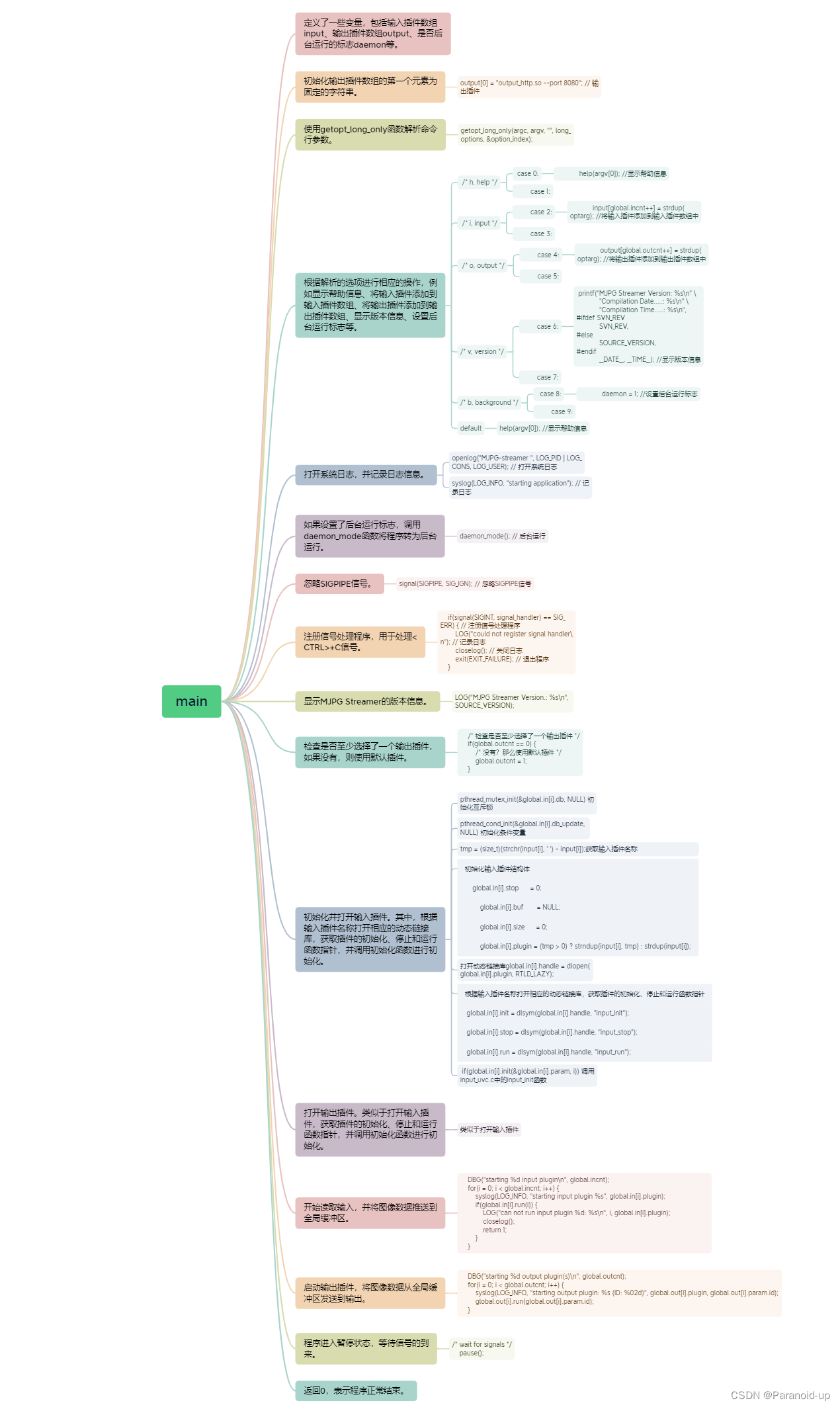
这个函数是一个C程序的主函数,接受命令行参数并执行相应的操作。下面是这个函数的要点:
定义了一些变量,包括输入插件数组input、输出插件数组output、是否后台运行的标志daemon等。
初始化输出插件数组的第一个元素为固定的字符串。
使用getopt_long_only函数解析命令行参数。
根据解析的选项进行相应的操作,例如显示帮助信息、将输入插件添加到输入插件数组、将输出插件添加到输出插件数组、显示版本信息、设置后台运行标志等。
打开系统日志,并记录日志信息。
如果设置了后台运行标志,调用daemon_mode函数将程序转为后台运行。
忽略SIGPIPE信号。
注册信号处理程序,用于处理+C信号。
显示MJPG Streamer的版本信息。
检查是否至少选择了一个输出插件,如果没有,则使用默认插件。
初始化并打开输入插件。其中,根据输入插件名称打开相应的动态链接库,获取插件的初始化、停止和运行函数指针,并调用初始化函数进行初始化。
打开输出插件。类似于打开输入插件,获取插件的初始化、停止和运行函数指针,并调用初始化函数进行初始化。
开始读取输入,并将图像数据推送到全局缓冲区。
启动输出插件,将图像数据从全局缓冲区发送到输出。
程序进入暂停状态,等待信号的到来。
返回0,表示程序正常结束。
总体来说,这个函数是一个简单的命令行程序,用于控制输入和输出插件的启动和运行,并提供一些选项来配置程序的行为。
/*******************************************************************************
# #
# MJPG-streamer allows to stream JPG frames from an input-plugin #
# to several output plugins #
# #
# Copyright (C) 2007 Tom Stöveken #
# #
# This program is free software; you can redistribute it and/or modify #
# it under the terms of the GNU General Public License as published by #
# the Free Software Foundation; version 2 of the License. #
# #
# This program is distributed in the hope that it will be useful, #
# but WITHOUT ANY WARRANTY; without even the implied warranty of #
# MERCHANTABILITY or FITNESS FOR A PARTICULAR PURPOSE. See the #
# GNU General Public License for more details. #
# #
# You should have received a copy of the GNU General Public License #
# along with this program; if not, write to the Free Software #
# Foundation, Inc., 59 Temple Place, Suite 330, Boston, MA 02111-1307 USA #
# #
*******************************************************************************/
#include <stdio.h>
#include <stdlib.h>
#include <unistd.h>
#include <string.h>
#include <linux/videodev2.h>
#include <sys/ioctl.h>
#include <errno.h>
#include <signal.h>
#include <sys/socket.h>
#include <arpa/inet.h>
#include <sys/types.h>
#include <sys/stat.h>
#include <getopt.h>
#include <pthread.h>
#include <dlfcn.h>
#include <fcntl.h>
#include <syslog.h>
#include "utils.h"
#include "mjpg_streamer.h"
/* globals */
static globals global;
/******************************************************************************
Description.: Display a help message
Input Value.: argv[0] is the program name and the parameter progname
Return Value: -
******************************************************************************/
void help(char *progname)
{
fprintf(stderr, "-----------------------------------------------------------------------\n");
fprintf(stderr, "Usage: %s\n" \
" -i | --input \"<input-plugin.so> [parameters]\"\n" \
" -o | --output \"<output-plugin.so> [parameters]\"\n" \
" [-h | --help ]........: display this help\n" \
" [-v | --version ].....: display version information\n" \
" [-b | --background]...: fork to the background, daemon mode\n", progname);
fprintf(stderr, "-----------------------------------------------------------------------\n");
fprintf(stderr, "Example #1:\n" \
" To open an UVC webcam \"/dev/video1\" and stream it via HTTP:\n" \
" %s -i \"input_uvc.so -d /dev/video1\" -o \"output_http.so\"\n", progname);
fprintf(stderr, "-----------------------------------------------------------------------\n");
fprintf(stderr, "Example #2:\n" \
" To open an UVC webcam and stream via HTTP port 8090:\n" \
" %s -i \"input_uvc.so\" -o \"output_http.so -p 8090\"\n", progname);
fprintf(stderr, "-----------------------------------------------------------------------\n");
fprintf(stderr, "Example #3:\n" \
" To get help for a certain input plugin:\n" \
" %s -i \"input_uvc.so --help\"\n", progname);
fprintf(stderr, "-----------------------------------------------------------------------\n");
fprintf(stderr, "In case the modules (=plugins) can not be found:\n" \
" * Set the default search path for the modules with:\n" \
" export LD_LIBRARY_PATH=/path/to/plugins,\n" \
" * or put the plugins into the \"/lib/\" or \"/usr/lib\" folder,\n" \
" * or instead of just providing the plugin file name, use a complete\n" \
" path and filename:\n" \
" %s -i \"/path/to/modules/input_uvc.so\"\n", progname);
fprintf(stderr, "-----------------------------------------------------------------------\n");
}
/******************************************************************************
Description.: pressing CTRL+C sends signals to this process instead of just
killing it plugins can tidily shutdown and free allocated
resources. The function prototype is defined by the system,
because it is a callback function.
Input Value.: sig tells us which signal was received
Return Value: -
******************************************************************************/
void signal_handler(int sig)
{
int i;
/* signal "stop" to threads */
LOG("setting signal to stop\n");
global.stop = 1;
usleep(1000 * 1000);
/* clean up threads */
LOG("force cancellation of threads and cleanup resources\n");
for(i = 0; i < global.incnt; i++) {
global.in[i].stop(i);
}
for(i = 0; i < global.outcnt; i++) {
global.out[i].stop(global.out[i].param.id);
pthread_cond_destroy(&global.in[i].db_update);
pthread_mutex_destroy(&global.in[i].db);
}
usleep(1000 * 1000);
/* close handles of input plugins */
for(i = 0; i < global.incnt; i++) {
dlclose(global.in[i].handle);
}
for(i = 0; i < global.outcnt; i++) {
/* skip = 0;
DBG("about to decrement usage counter for handle of %s, id #%02d, handle: %p\n", \
global.out[i].plugin, global.out[i].param.id, global.out[i].handle);
for(j=i+1; j<global.outcnt; j++) {
if ( global.out[i].handle == global.out[j].handle ) {
DBG("handles are pointing to the same destination (%p == %p)\n", global.out[i].handle, global.out[j].handle);
skip = 1;
}
}
if ( skip ) {
continue;
}
DBG("closing handle %p\n", global.out[i].handle);
*/
dlclose(global.out[i].handle);
}
DBG("all plugin handles closed\n");
LOG("done\n");
closelog();
exit(0);
return;
}
int split_parameters(char *parameter_string, int *argc, char **argv)
{
int count = 1;
argv[0] = NULL; // the plugin may set it to 'INPUT_PLUGIN_NAME'
if(parameter_string != NULL && strlen(parameter_string) != 0) {
char *arg = NULL, *saveptr = NULL, *token = NULL;
arg = strdup(parameter_string);
if(strchr(arg, ' ') != NULL) {
token = strtok_r(arg, " ", &saveptr);
if(token != NULL) {
argv[count] = strdup(token);
count++;
while((token = strtok_r(NULL, " ", &saveptr)) != NULL) {
argv[count] = strdup(token);
count++;
if(count >= MAX_PLUGIN_ARGUMENTS) {
IPRINT("ERROR: too many arguments to input plugin\n");
return 0;
}
}
}
}
}
*argc = count;
return 1;
}
/******************************************************************************
Description.:
Input Value.:
Return Value:
******************************************************************************/
int main(int argc, char *argv[])
{
//char *input = "input_uvc.so --resolution 640x480 --fps 5 --device /dev/video0";
char *input[MAX_INPUT_PLUGINS]; // 输入插件数组
char *output[MAX_OUTPUT_PLUGINS]; // 输出插件数组
int daemon = 0, i; // 是否后台运行
size_t tmp = 0;
output[0] = "output_http.so --port 8080"; // 输出插件
global.outcnt = 0; // 输出插件数量
/* parameter parsing */
//解析参数getopt_long_only
while(1) {
int option_index = 0, c = 0;
static struct option long_options[] = {
{"h", no_argument, 0, 0
},
{"help", no_argument, 0, 0},
{"i", required_argument, 0, 0},
{"input", required_argument, 0, 0},
{"o", required_argument, 0, 0},
{"output", required_argument, 0, 0},
{"v", no_argument, 0, 0},
{"version", no_argument, 0, 0},
{"b", no_argument, 0, 0},
{"background", no_argument, 0, 0},
{0, 0, 0, 0}
};
c = getopt_long_only(argc, argv, "", long_options, &option_index); //获取参数
/* no more options to parse */
if(c == -1) break;
/* unrecognized option */
if(c == '?') {
help(argv[0]);
return 0;
}
switch(option_index) {
/* h, help */
case 0:
case 1:
help(argv[0]); //显示帮助信息
return 0;
break;
/* i, input */
case 2:
case 3:
input[global.incnt++] = strdup(optarg); //将输入插件添加到输入插件数组中
break;
/* o, output */
case 4:
case 5:
output[global.outcnt++] = strdup(optarg); //将输出插件添加到输出插件数组中
break;
/* v, version */
case 6:
case 7:
printf("MJPG Streamer Version: %s\n" \
"Compilation Date.....: %s\n" \
"Compilation Time.....: %s\n",
#ifdef SVN_REV
SVN_REV,
#else
SOURCE_VERSION,
#endif
__DATE__, __TIME__); //显示版本信息
return 0;
break;
/* b, background */
case 8:
case 9:
daemon = 1; //设置后台运行标志
break;
default:
help(argv[0]); //显示帮助信息
return 0;
}
}
openlog("MJPG-streamer ", LOG_PID | LOG_CONS, LOG_USER); // 打开系统日志
//openlog("MJPG-streamer ", LOG_PID|LOG_CONS|LOG_PERROR, LOG_USER);
syslog(LOG_INFO, "starting application"); // 记录日志
/* fork to the background */
if(daemon) { // 后台运行
LOG("enabling daemon mode"); // 记录日志
daemon_mode(); // 后台运行
}
/* ignore SIGPIPE (send by OS if transmitting to closed TCP sockets) */
signal(SIGPIPE, SIG_IGN); // 忽略SIGPIPE信号
/* register signal handler for <CTRL>+C in order to clean up */
if(signal(SIGINT, signal_handler) == SIG_ERR) { // 注册信号处理程序
LOG("could not register signal handler\n"); // 记录日志
closelog(); // 关闭日志
exit(EXIT_FAILURE); // 退出程序
}
/*
* messages like the following will only be visible on your terminal
* if not running in daemon mode
*/
#ifdef SVN_REV
LOG("MJPG Streamer Version: svn rev: %s\n", SVN_REV);
#else
LOG("MJPG Streamer Version.: %s\n", SOURCE_VERSION); // 如果没有SVN_REV,则使用SOURCE_VERSION
#endif
/* 检查是否至少选择了一个输出插件 */
if(global.outcnt == 0) {
/* 没有?那么使用默认插件 */
global.outcnt = 1;
}
/* 打开输入插件 */
for(i = 0; i < global.incnt; i++) {
if(pthread_mutex_init(&global.in[i].db, NULL) != 0) { // 初始化互斥锁
LOG("could not initialize mutex variable\n"); // 记录日志
closelog(); // 关闭日志
exit(EXIT_FAILURE); // 退出程序
}
if(pthread_cond_init(&global.in[i].db_update, NULL) != 0) { // 初始化条件变量
LOG("could not initialize condition variable\n"); // 记录日志
closelog(); // 关闭日志
exit(EXIT_FAILURE); // 退出程序
}
// 获取输入插件名称
tmp = (size_t)(strchr(input[i], ' ') - input[i]);
// 初始化输入插件结构体
global.in[i].stop = 0;
global.in[i].buf = NULL;
global.in[i].size = 0;
global.in[i].plugin = (tmp > 0) ? strndup(input[i], tmp) : strdup(input[i]);
// 打开输入插件
global.in[i].handle = dlopen(global.in[i].plugin, RTLD_LAZY);打开动态链接库
if(!global.in[i].handle) {
LOG("ERROR: could not find input plugin\n");
LOG(" Perhaps you want to adjust the search path with:\n");
LOG(" # export LD_LIBRARY_PATH=/path/to/plugin/folder\n");
LOG(" dlopen: %s\n", dlerror());
closelog();
exit(EXIT_FAILURE);
}
global.in[i].init = dlsym(global.in[i].handle, "input_init");//让init函数指针等于打开的动态链接库中的init函数
if(global.in[i].init == NULL) {
LOG("%s\n", dlerror());
exit(EXIT_FAILURE);
}
global.in[i].stop = dlsym(global.in[i].handle, "input_stop");
if(global.in[i].stop == NULL) {
LOG("%s\n", dlerror());
exit(EXIT_FAILURE);
}
global.in[i].run = dlsym(global.in[i].handle, "input_run");
if(global.in[i].run == NULL) {
LOG("%s\n", dlerror());
exit(EXIT_FAILURE);
}
/* 尝试找到可选命令 */
global.in[i].cmd = dlsym(global.in[i].handle, "input_cmd");
global.in[i].param.parameters = strchr(input[i], ' ');
split_parameters(global.in[i].param.parameters, &global.in[i].param.argc, global.in[i].param.argv);
global.in[i].param.global = &global;
global.in[i].param.id = i;
if(global.in[i].init(&global.in[i].param, i)) {
LOG("input_init() return value signals to exit\n");
closelog();
exit(0);
}
}
/* open output plugin */
for(i = 0; i < global.outcnt; i++) {
tmp = (size_t)(strchr(output[i], ' ') - output[i]);
global.out[i].plugin = (tmp > 0) ? strndup(output[i], tmp) : strdup(output[i]);
global.out[i].handle = dlopen(global.out[i].plugin, RTLD_LAZY);
if(!global.out[i].handle) {
LOG("ERROR: could not find output plugin %s\n", global.out[i].plugin);
LOG(" Perhaps you want to adjust the search path with:\n");
LOG(" # export LD_LIBRARY_PATH=/path/to/plugin/folder\n");
LOG(" dlopen: %s\n", dlerror());
closelog();
exit(EXIT_FAILURE);
}
global.out[i].init = dlsym(global.out[i].handle, "output_init");
if(global.out[i].init == NULL) {
LOG("%s\n", dlerror());
exit(EXIT_FAILURE);
}
global.out[i].stop = dlsym(global.out[i].handle, "output_stop");
if(global.out[i].stop == NULL) {
LOG("%s\n", dlerror());
exit(EXIT_FAILURE);
}
global.out[i].run = dlsym(global.out[i].handle, "output_run");
if(global.out[i].run == NULL) {
LOG("%s\n", dlerror());
exit(EXIT_FAILURE);
}
/* try to find optional command */
global.out[i].cmd = dlsym(global.out[i].handle, "output_cmd");
global.out[i].param.parameters = strchr(output[i], ' ');
split_parameters(global.out[i].param.parameters, &global.out[i].param.argc, global.out[i].param.argv);
global.out[i].param.global = &global;
global.out[i].param.id = i;
if(global.out[i].init(&global.out[i].param, i)) {
LOG("output_init() return value signals to exit\n");
closelog();
exit(0);
}
}
/* start to read the input, push pictures into global buffer */
DBG("starting %d input plugin\n", global.incnt);
for(i = 0; i < global.incnt; i++) {
syslog(LOG_INFO, "starting input plugin %s", global.in[i].plugin);
if(global.in[i].run(i)) {
LOG("can not run input plugin %d: %s\n", i, global.in[i].plugin);
closelog();
return 1;
}
}
DBG("starting %d output plugin(s)\n", global.outcnt);
for(i = 0; i < global.outcnt; i++) {
syslog(LOG_INFO, "starting output plugin: %s (ID: %02d)", global.out[i].plugin, global.out[i].param.id);
global.out[i].run(global.out[i].param.id);
}
/* wait for signals */
pause();//等待信号
return 0;
}
input_init
这个input_init函数是用于初始化视频设备输入参数的函数。函数接受一个input_parameter类型的指针参数param和一个整数参数id。以下是函数的主要步骤和功能:
初始化互斥变量cams[id].controls_mutex,使用pthread_mutex_init函数。
设置默认的设备路径、宽度、高度、帧率和格式等参数。
解析命令行参数,使用getopt_long_only函数进行参数解析,并将解析的值赋给相应的参数变量。
将解析的参数值赋给param结构体。
分配并初始化cams[id].videoIn结构体。
打开视频设备并准备数据结构,调用init_videoIn函数。
如果设置了dynctrls标志,使用initDynCtrls函数初始化动态控制。
枚举V4L2控制项,调用enumerateControls函数。
在成功时返回0,否则可能显示错误消息并退出程序。
int input_init(input_parameter *param, int id)
{
char *dev = "/dev/video0", *s;
int width = 640, height = 480, fps = 5, format = V4L2_PIX_FMT_MJPEG, i;
/* initialize the mutes variable */
if(pthread_mutex_init(&cams[id].controls_mutex, NULL) != 0) {
IPRINT("could not initialize mutex variable\n");
exit(EXIT_FAILURE);
}
param->argv[0] = INPUT_PLUGIN_NAME;
/* show all parameters for DBG purposes */
for(i = 0; i < param->argc; i++) {
DBG("argv[%d]=%s\n", i, param->argv[i]);
}
/* parse the parameters */
reset_getopt();
while(1) {
int option_index = 0, c = 0;
static struct option long_options[] = {
{"h", no_argument, 0, 0
},
{"help", no_argument, 0, 0},
{"d", required_argument, 0, 0},
{"device", required_argument, 0, 0},
{"r", required_argument, 0, 0},
{"resolution", required_argument, 0, 0},
{"f", required_argument, 0, 0},
{"fps", required_argument, 0, 0},
{"y", no_argument, 0, 0},
{"yuv", no_argument, 0, 0},
{"q", required_argument, 0, 0},
{"quality", required_argument, 0, 0},
{"m", required_argument, 0, 0},
{"minimum_size", required_argument, 0, 0},
{"n", no_argument, 0, 0},
{"no_dynctrl", no_argument, 0, 0},
{"l", required_argument, 0, 0},
{"led", required_argument, 0, 0},
{0, 0, 0, 0}
};
/* parsing all parameters according to the list above is sufficent */
c = getopt_long_only(param->argc, param->argv, "", long_options, &option_index);
/* no more options to parse */
if(c == -1) break;
/* unrecognized option */
if(c == '?') {
help();
return 1;
}
/* dispatch the given options */
switch(option_index) {
/* h, help */
case 0:
case 1:
DBG("case 0,1\n");
help();
return 1;
break;
/* d, device */
case 2:
case 3:
DBG("case 2,3\n");
dev = strdup(optarg);
break;
/* r, resolution */
case 4:
case 5:
DBG("case 4,5\n");
width = -1;
height = -1;
/* try to find the resolution in lookup table "resolutions" */
for(i = 0; i < LENGTH_OF(resolutions); i++) {
if(strcmp(resolutions[i].string, optarg) == 0) {
width = resolutions[i].width;
height = resolutions[i].height;
}
}
/* done if width and height were set */
if(width != -1 && height != -1)
break;
/* parse value as decimal value */
width = strtol(optarg, &s, 10);
height = strtol(s + 1, NULL, 10);
break;
/* f, fps */
case 6:
case 7:
DBG("case 6,7\n");
fps = atoi(optarg);
break;
/* y, yuv */
case 8:
case 9:
DBG("case 8,9\n");
format = V4L2_PIX_FMT_YUYV;
break;
/* q, quality */
case 10:
case 11:
DBG("case 10,11\n");
format = V4L2_PIX_FMT_YUYV;
gquality = MIN(MAX(atoi(optarg), 0), 100);
break;
/* m, minimum_size */
case 12:
case 13:
DBG("case 12,13\n");
minimum_size = MAX(atoi(optarg), 0);
break;
/* n, no_dynctrl */
case 14:
case 15:
DBG("case 14,15\n");
dynctrls = 0;
break;
/* l, led */
case 16:
case 17:/*
DBG("case 16,17\n");
if ( strcmp("on", optarg) == 0 ) {
led = IN_CMD_LED_ON;
} else if ( strcmp("off", optarg) == 0 ) {
led = IN_CMD_LED_OFF;
} else if ( strcmp("auto", optarg) == 0 ) {
led = IN_CMD_LED_AUTO;
} else if ( strcmp("blink", optarg) == 0 ) {
led = IN_CMD_LED_BLINK;
}*/
break;
default:
DBG("default case\n");
help();
return 1;
}
}
DBG("input id: %d\n", id);
cams[id].id = id;
cams[id].pglobal = param->global;
/* allocate webcam datastructure */
cams[id].videoIn = malloc(sizeof(struct vdIn));
if(cams[id].videoIn == NULL) {
IPRINT("not enough memory for videoIn\n");
exit(EXIT_FAILURE);
}
memset(cams[id].videoIn, 0, sizeof(struct vdIn));
/* display the parsed values */
IPRINT("Using V4L2 device.: %s\n", dev);
IPRINT("Desired Resolution: %i x %i\n", width, height);
IPRINT("Frames Per Second.: %i\n", fps);
IPRINT("Format............: %s\n", (format == V4L2_PIX_FMT_YUYV) ? "YUV" : "MJPEG");
if(format == V4L2_PIX_FMT_YUYV)
IPRINT("JPEG Quality......: %d\n", gquality);
DBG("vdIn pn: %d\n", id);
/* open video device and prepare data structure */
if(init_videoIn(cams[id].videoIn, dev, width, height, fps, format, 1, cams[id].pglobal, id) < 0) { // 如果初始化视频输入失败
IPRINT("init_VideoIn failed\n"); // 输出错误信息
closelog(); // 关闭日志
exit(EXIT_FAILURE); // 退出程序
}
/*
* recent linux-uvc driver (revision > ~#125) requires to use dynctrls
* dynctrls must get initialized
*/ // 最近的Linux-UVC驱动程序(版本>〜#125)需要使用dynctrls,dynctrls必须得到初始化
if(dynctrls) // 如果dynctrls为真
initDynCtrls(cams[id].videoIn->fd); // 初始化dynctrls
enumerateControls(cams[id].videoIn, cams[id].pglobal, id); // 枚举V4L2控件在UVC扩展映射之后
return 0;
}
input_run
input_run函数用于启动摄像头线程。它接收一个整数id作为参数,并执行以下步骤:
使用malloc函数为cams[id].pglobal->in[id].buf分配内存,大小为cams[id].videoIn->framesizeIn。如果内存分配失败,则打印错误消息并退出程序。
打印调试信息,指示正在启动摄像头线程。
使用pthread_create函数创建线程,并将上下文&(cams[id])传递给线程函数cam_thread。线程的ID存储在cams[id].threadID中。
使用pthread_detach函数将线程设置为可分离状态,以便线程结束时可以自动清理资源。
在函数执行成功时返回0。
// 启动输入线程
int input_run(int id)
{
// 为输入缓冲区分配内存
cams[id].pglobal->in[id].buf = malloc(cams[id].videoIn->framesizeIn);
if(cams[id].pglobal->in[id].buf == NULL) { // 如果分配内存失败
fprintf(stderr, "could not allocate memory\n"); // 输出错误信息
exit(EXIT_FAILURE); // 退出程序
}
DBG("launching camera thread #%02d\n", id);
/* create thread and pass context to thread function */
pthread_create(&(cams[id].threadID), NULL, cam_thread, &(cams[id])); // 创建线程并将上下文传递给线程函数
pthread_detach(cams[id].threadID); // 分离线程
return 0;
}
output_init
这段代码是output_init函数的实现。该函数用于初始化输出插件的参数和配置。
函数接收两个参数:一个指向output_parameter结构体的指针param和一个整数id。
函数的主要步骤如下:
打印调试信息,指示正在初始化输出插件,并打印输出插件的ID。
初始化变量
port为8080,
credentials和
www_folder为NULL,
nocommands为0。
设置
param->argv[0]为输出插件的名称。
打印调试信息,显示所有参数的值(用于调试目的)。
重置
getopt状态,准备进行命令行参数解析。
进入循环,解析命令行参数,直到没有更多的选项可解析。
如果遇到未识别的选项,则调用
help函数打印帮助信息,并返回1表示初始化失败。
根据选项的索引执行相应的操作:
对于"h"和"help"选项,打印帮助信息,并返回1表示初始化失败。
对于"p"和"port"选项,将端口号转换为网络字节序,并赋值给
port变量。
对于"c"和"credentials"选项,将参数的字符串拷贝到
credentials变量中。
对于"w"和"www"选项,分配内存并将参数的字符串拷贝到
www_folder变量中,并确保字符串末尾有"/"。
对于"n"和"nocommands"选项,将
nocommands变量设置为1。
将输出插件的ID、全局上下文指针、配置参数赋值给相应的输出服务器结构体。
打印输出插件的配置信息,包括www文件夹路径、HTTP TCP端口号、用户名和密码(如果已设置)、命令是否启用。
在函数执行成功时返回0。
需要注意的是,代码片段中缺少一些函数和变量的定义,以及头文件的包含。此外,需要查看output_parameter结构体的定义,才能完全理解这段代码的功能和上下文关系。
int output_init(output_parameter *param, int id)
{
int i;
int port;
char *credentials, *www_folder;
char nocommands;
DBG("output #%02d\n", param->id);
port = htons(8080);
credentials = NULL;
www_folder = NULL;
nocommands = 0;
param->argv[0] = OUTPUT_PLUGIN_NAME;
/* show all parameters for DBG purposes */
for(i = 0; i < param->argc; i++) {
DBG("argv[%d]=%s\n", i, param->argv[i]);
}
reset_getopt();
while(1) {
int option_index = 0, c = 0;
static struct option long_options[] = {
{"h", no_argument, 0, 0
},
{"help", no_argument, 0, 0},
{"p", required_argument, 0, 0},
{"port", required_argument, 0, 0},
{"c", required_argument, 0, 0},
{"credentials", required_argument, 0, 0},
{"w", required_argument, 0, 0},
{"www", required_argument, 0, 0},
{"n", no_argument, 0, 0},
{"nocommands", no_argument, 0, 0},
{0, 0, 0, 0}
};
c = getopt_long_only(param->argc, param->argv, "", long_options, &option_index);
/* no more options to parse */
if(c == -1) break;
/* unrecognized option */
if(c == '?') {
help();
return 1;
}
switch(option_index) {
/* h, help */
case 0:
case 1:
DBG("case 0,1\n");
help();
return 1;
break;
/* p, port */
case 2:
case 3:
DBG("case 2,3\n");
port = htons(atoi(optarg));
break;
/* c, credentials */
case 4:
case 5:
DBG("case 4,5\n");
credentials = strdup(optarg);
break;
/* w, www */
case 6:
case 7:
DBG("case 6,7\n");
www_folder = malloc(strlen(optarg) + 2);
strcpy(www_folder, optarg);
if(optarg[strlen(optarg)-1] != '/')
strcat(www_folder, "/");
break;
/* n, nocommands */
case 8:
case 9:
DBG("case 8,9\n");
nocommands = 1;
break;
}
}
servers[param->id].id = param->id;
servers[param->id].pglobal = param->global;
servers[param->id].conf.port = port;
servers[param->id].conf.credentials = credentials;
servers[param->id].conf.www_folder = www_folder;
servers[param->id].conf.nocommands = nocommands;
OPRINT("www-folder-path...: %s\n", (www_folder == NULL) ? "disabled" : www_folder);
OPRINT("HTTP TCP port.....: %d\n", ntohs(port));
OPRINT("username:password.: %s\n", (credentials == NULL) ? "disabled" : credentials);
OPRINT("commands..........: %s\n", (nocommands) ? "disabled" : "enabled");
return 0;
}
output_run
给定的代码是一个名为output_run的函数,用于在新线程中运行输出服务器。它接受一个整数id作为输入,表示服务器的ID。
以下是代码的详细解析:
函数使用
DBG宏打印输出的服务器线程的序号(id)。
函数使用
pthread_create函数创建一个新线程,并将服务器结构体&(servers[id])作为参数传递给线程函数server_thread。
函数使用
pthread_detach函数将线程标记为可分离的,这意味着线程的资源将在退出时自动释放,无需等待主线程的显式回收。
函数返回0以表示成功启动服务器线程。
总体而言,该函数负责在新线程中启动输出服务器。它创建一个线程并将服务器结构体作为参数传递给线程函数,然后将线程标记为可分离的。这样可以使服务器在独立的线程中运行,而主线程可以继续执行其他任务。
int output_run(int id)
{
DBG(“launching server thread #%02d\n”, id);
/* create thread and pass context to thread function */
pthread_create(&(servers[id].threadID), NULL, server_thread, &(servers[id]));
pthread_detach(servers[id].threadID);
return 0;
}
server_thread
给定的代码是一个名为server_thread的线程函数,用于处理客户端连接的请求。它接受一个void*类型的参数arg,在函数内部将其转换为指向context结构体的指针。
以下是代码的详细解析:
函数从传递给线程函数的参数中获取服务器的全局上下文指针
pglobal。
函数使用
pthread_cleanup_push宏设置清理处理程序server_cleanup,以确保在线程退出时释放资源。
函数使用
getaddrinfo函数根据服务器的端口号获取地址信息。
函数初始化一些变量和数据结构,如套接字描述符数组
sd和用于存储客户端信息的数据结构(如果定义了MANAGMENT)。
函数循环遍历地址信息列表,为每个地址创建套接字,并进行绑定和监听操作。
如果成功创建了一个监听套接字,将其加入到
select函数的文件描述符集合中。
函数使用
select函数阻塞等待可读事件的发生,以接受新的客户端连接。
一旦有客户端连接请求到达监听套接字,函数将接受该连接,并为每个连接创建一个新线程来处理客户端请求。
函数将客户端连接的套接字描述符和服务器的上下文信息封装到
cfd结构体中,并将其作为参数传递给client_thread线程函数。
函数打印正在为哪个客户端提供服务,并根据需要记录客户端的信息(如果定义了
MANAGMENT)。
函数使用
pthread_create函数创建一个新线程来处理客户端连接,并将cfd结构体作为参数传递给线程函数。
函数将新线程标记为可分离的,并继续等待下一个客户端连接。
当全局变量
pglobal->stop为真时,表示需要停止服务器运行,循环结束。
函数在退出之前调用清理处理程序来释放资源,并使用
pthread_cleanup_pop宏进行清理处理程序的弹出。
函数返回
NULL,线程结束。
总体而言,该函数在一个独立的线程中运行,用于接受客户端的连接请求,并为每个连接创建一个新线程来处理客户端请求。它使用select函数进行阻塞等待,以便及时响应新的客户端连接。
void *server_thread(void *arg)
{
int on;
pthread_t client;
struct addrinfo *aip, *aip2;
struct addrinfo hints;
struct sockaddr_storage client_addr;
socklen_t addr_len = sizeof(struct sockaddr_storage);
fd_set selectfds;
int max_fds = 0;
char name[NI_MAXHOST];
int err;
int i;
context *pcontext = arg;
pglobal = pcontext->pglobal;
/* set cleanup handler to cleanup ressources */
pthread_cleanup_push(server_cleanup, pcontext);
bzero(&hints, sizeof(hints));
hints.ai_family = PF_UNSPEC;
hints.ai_flags = AI_PASSIVE;
hints.ai_socktype = SOCK_STREAM;
snprintf(name, sizeof(name), "%d", ntohs(pcontext->conf.port));
if((err = getaddrinfo(NULL, name, &hints, &aip)) != 0) {
perror(gai_strerror(err));
exit(EXIT_FAILURE);
}
for(i = 0; i < MAX_SD_LEN; i++)
pcontext->sd[i] = -1;
#ifdef MANAGMENT
if (pthread_mutex_init(&client_infos.mutex, NULL)) {
perror("Mutex initialization failed");
exit(EXIT_FAILURE);
}
client_infos.client_count = 0;
client_infos.infos = NULL;
#endif
/* open sockets for server (1 socket / address family) */
i = 0;
for(aip2 = aip; aip2 != NULL; aip2 = aip2->ai_next) {
if((pcontext->sd[i] = socket(aip2->ai_family, aip2->ai_socktype, 0)) < 0) {
continue;
}
/* ignore "socket already in use" errors */
on = 1;
if(setsockopt(pcontext->sd[i], SOL_SOCKET, SO_REUSEADDR, &on, sizeof(on)) < 0) {
perror("setsockopt(SO_REUSEADDR) failed\n");
}
/* IPv6 socket should listen to IPv6 only, otherwise we will get "socket already in use" */
on = 1;
if(aip2->ai_family == AF_INET6 && setsockopt(pcontext->sd[i], IPPROTO_IPV6, IPV6_V6ONLY,
(const void *)&on , sizeof(on)) < 0) {
perror("setsockopt(IPV6_V6ONLY) failed\n");
}
/* perhaps we will use this keep-alive feature oneday */
/* setsockopt(sd, SOL_SOCKET, SO_KEEPALIVE, &on, sizeof(on)); */
if(bind(pcontext->sd[i], aip2->ai_addr, aip2->ai_addrlen) < 0) {
perror("bind");
pcontext->sd[i] = -1;
continue;
}
if(listen(pcontext->sd[i], 10) < 0) {
perror("listen");
pcontext->sd[i] = -1;
} else {
i++;
if(i >= MAX_SD_LEN) {
OPRINT("%s(): maximum number of server sockets exceeded", __FUNCTION__);
i--;
break;
}
}
}
pcontext->sd_len = i;
if(pcontext->sd_len < 1) {
OPRINT("%s(): bind(%d) failed\n", __FUNCTION__, htons(pcontext->conf.port));
closelog();
exit(EXIT_FAILURE);
}
/* create a child for every client that connects */
while(!pglobal->stop) {
//int *pfd = (int *)malloc(sizeof(int));
cfd *pcfd = malloc(sizeof(cfd));
if(pcfd == NULL) {
fprintf(stderr, "failed to allocate (a very small amount of) memory\n");
exit(EXIT_FAILURE);
}
DBG("waiting for clients to connect\n");
do {
FD_ZERO(&selectfds);
for(i = 0; i < MAX_SD_LEN; i++) {
if(pcontext->sd[i] != -1) {
FD_SET(pcontext->sd[i], &selectfds);
if(pcontext->sd[i] > max_fds)
max_fds = pcontext->sd[i];
}
}
err = select(max_fds + 1, &selectfds, NULL, NULL, NULL);
if(err < 0 && errno != EINTR) {
perror("select");
exit(EXIT_FAILURE);
}
} while(err <= 0);
for(i = 0; i < max_fds + 1; i++) {
if(pcontext->sd[i] != -1 && FD_ISSET(pcontext->sd[i], &selectfds)) {
pcfd->fd = accept(pcontext->sd[i], (struct sockaddr *)&client_addr, &addr_len);
pcfd->pc = pcontext;
/* start new thread that will handle this TCP connected client */
DBG("create thread to handle client that just established a connection\n");
if(getnameinfo((struct sockaddr *)&client_addr, addr_len, name, sizeof(name), NULL, 0, NI_NUMERICHOST) == 0) {
syslog(LOG_INFO, "serving client: %s\n", name);
DBG("serving client: %s\n", name);
}
#if defined(MANAGMENT)
pcfd->client = add_client(name);
#endif
if(pthread_create(&client, NULL, &client_thread, pcfd) != 0) {
DBG("could not launch another client thread\n");
close(pcfd->fd);
free(pcfd);
continue;
}
pthread_detach(client);
}
}
}
DBG("leaving server thread, calling cleanup function now\n");
pthread_cleanup_pop(1);
return NULL;
}



